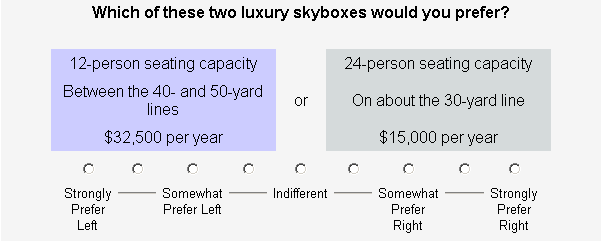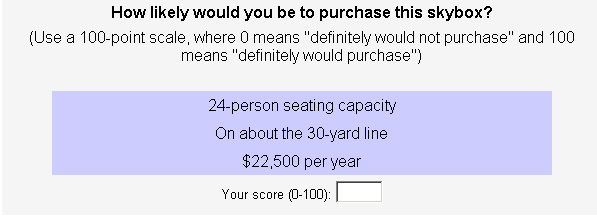CVA offers two main questionnaire layout options: single concept (ranking or rating), and pairwise comparison (ratings only). The approach you use is driven by which format best reflects decision-making for the market you are studying, and the kinds of data analysis you need to perform.
Once you have entered your attributes and levels and specified a layout (single-concept or pairwise comparison) you are ready to generate an experimental design (the conjoint questions). CVA's designer uses a computer search algorithm that seeks to maximize D-efficiency, given the specifications for your study (i.e. attributes and levels, and number of requested tasks). Designs with high D-efficiency support independent and relatively efficient estimation of the part-worths.
Pairwise Presentation
CVA uses Pairwise Comparison as the default design and question presentation format. With pairwise presentation, respondents are asked to compare two products, as shown below:

With small numbers of attributes, the paired comparison format has desirable characteristics. Paired comparisons have a long history in the field of psychometrics, where they have been the method of choice for the precise measurement of small subjective differences. When respondents compare two products side-by-side, it can help them draw finer distinctions between products offering different features. However, if two products are shown per question, respondents are asked to evaluate twice as much information as single concept designs (described below). All research we are aware of to date suggests that relative part-worths are very similar whether estimated from single concept or paired comparison conjoint questionnaire formats.
We suggest the pairwise design for most CVA-type conjoint projects. However, the pairwise questionnaire only captures the relative differences in a respondent's preferences for attribute levels. Pairwise questions never measure respondents' absolute level of interest in the product concepts. Comparative information is all that is necessary for estimating relative part-worths and running competitive market simulations. If you need to run "purchase likelihood" simulations within the market simulator, you should use the single concept presentation, described next.
Single Concept Presentation
Single concept presentation is commonly known as "card-sort." Respondents can be shown one product at a time and asked to rate how desirable each is or how likely they would be to purchase each. An example is shown below:

This method is particularly useful if the "purchase likelihood model" is to be used in the simulator. CVA's ordinary least squares (OLS) routine is appropriate for analyzing single concept ratings.
Alternatively, each of a set of product profiles can be printed on individual cards, and respondents can be asked to sort the cards from most to least preferred. In this case, the responses are rank orders of preference, and CVA's monotone regression routine is suggested for developing utilities. Ranking tasks (like pairwise comparisons) only elicit comparative information.